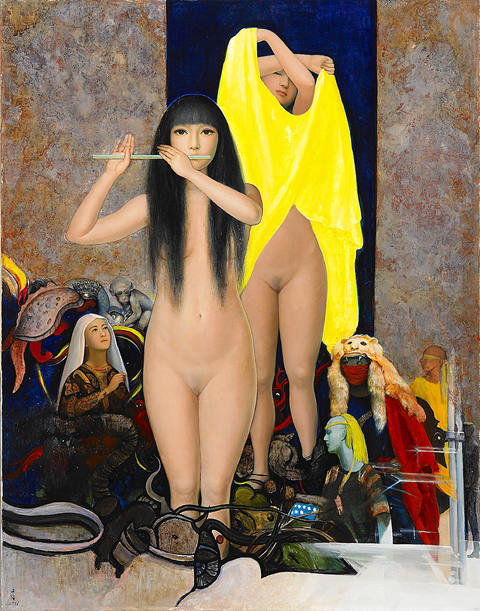Taipei’s gallery and museum scene has become transfixed on young artists who work in a variety of media, are technically competent, take inspiration from global culture and blur the boundaries between installation and more traditional forms of art. Metaphysical Art Gallery refreshingly veers to the latter with Truly Hero, an exhibition of the work of nine Taiwanese artists, all born between 1945 and 1955 and who work mostly in acrylic and oil.
Curator and gallery owner Celia Huang (黃慈美), who helped mount Animamix at Sun Yat-sen Memorial Hall in October last year, chose the exhibition’s title as a tribute to the emerging artists’ struggles for recognition during the 1980s and 1990s when only a handful of collectors were interested in Taiwan’s nascent contemporary art market. With most of the works already sold, however, it seems that Taiwan’s contemporary art market has come into its own.
Lee Ming-tse (李明則) brings to life his memories of living in different parts of Taiwan in Vanity Fair (大千世界). A traditional temple procession complete with the divine dancing Eight Generals (八家將), firecrackers and worshippers plays out in front of a temple, while further up the canvas there is a familiar scene of Taipei’s barrack-style buildings — here done in intense reds, greens and blues — with bridges and an MRT station running through the entire scene.

PHOTO : COURTESY OF METAPHYSICAL ART GALLERY
Bridges, overpasses and underpasses form the heart of Lu Hsien-ming’s (陸先銘) large canvases. The concrete arteries built during Taiwan’s rapid modernization, Lu’s paintings suggest, have destroyed the natural environment. Lu’s Flower Sacrifice (花祭) features a lone flower surrounded by cement trucks and overshadowed by buildings that threaten to block out the sunlight.
Lin Wen-Chiang’s (林文強) Plentiful Harvest (豐收) is a social realist oil painting of two children dressed in blue rags leaning against their peasant mother who wears an orange frock gown and holds a basket piled with wheat. The scene of poverty contrasts the artists earlier style, as exemplified in Temptation (惑), a sensuous work with naked nymphs, religious symbolism and tribal figures.
Taiwan’s migratory and colonial history serves as a tableau for Wu Tien-chang’s (吳天章) two portrait paintings Japan Colony Age (關於日據時代的聯想) and Ancestor Series — To Taiwan (先民系利 — 過海來台). The figures for each stare directly at the viewer in an almost challenging manner. Wu’s later works, such as Overwhelming (移山倒海術), shift to laser printing and employ Buddhist and Taoist symbolism to depict a person’s emotional landscape.
Cheng Chien-chang’s (鄭建昌) Gene Code of Spirits (靈魂遺傳符碼), like Wu’s portraits, deconstructs Taiwan’s history in a diptych, one panel of a man and one of a woman. Surrounding the pair, whose ethnicity seems to be purposely ambiguous to highlight Taiwan’s multicultural heritage, are a variety of motifs: boats, Aborigines, the Presidential Office building. The Feet Stepping on the Land (踩在地上的腳) features a large foot vaguely shaped like Taiwan, with mountains, plains and seas that could be taken from an 18th-century map.
One small quibble about the show is that the artist’s earlier works aren’t hung with the later works. Huang said this was because the gallery isn’t large enough to show all the works at once.

Feces, vomit and fossilized food from inside stomachs have provided new clues into how dinosaurs rose to dominate Earth, a new study revealed on Wednesday. Scientists have discovered plenty about dinosaurs — particularly about how they vanished off the face of the planet 66 millions years ago. But “we know very little about their rise,” said Martin Qvarnstrom, a researcher at Sweden’s Uppsala University and the study’s lead author. Dinosaurs first appeared at least 230 million years ago, fossils have shown. But they would not become the world’s dominant animal until the start of the Jurassic Period some 30 million years later. What caused this

Last week, the government rejected a petition to amend the law that would allow permanent residents a path to citizenship. This was widely expected, but it came amid a flurry of negative trends about the future of the nation’s labor force. There was much ironic commentary on the juxtaposition of that decision with its idiotic, abusive reasoning with the urgent demand for labor across a wide range of fields. This demand was highlighted by the government’s plans for five NT$10 billion (US$307.6 million) funds to promote development in key fields, including artificial intelligence (AI), “smart” healthcare and green growth announced

The Mountains to Sea National Greenway (山海圳國家綠道) draws its name from the idea that each hiker starting at the summit of Jade Mountain (玉山) and following the trail to the coast is like a single raindrop. Together, many raindrops form life and prosperity-bringing waterways. Replicating a raindrop’s journey holds poetic beauty, but all hikers know that climbing is infinitely more appealing, and so this installment picks up where the last one left off — heading inland and uphill along the 49.8-kilometer Canal Trail (大圳之路) — second of the Greenway’s four sections. A detailed map of the trail can be found

“Bro, I can’t wait for my first dead body,” wrote an 11-year-old boy on Instagram in Sweden, where gangs recruit children too young to be prosecuted as contract killers on chat apps. “Stay motivated, it’ll come,” answered his 19-year-old contact. He went on to offer the child 150,000 kronor (US$13,680) to carry out a murder, as well as clothes and transport to the scene of the crime, according to a police investigation of the exchange last year in the western province of Varmland. In this case, four men aged 18 to 20 are accused of recruiting four minors aged 11 to 17